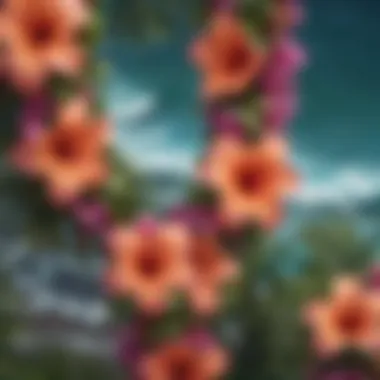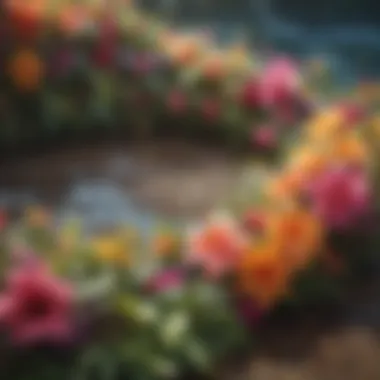Exploring Hawaiian Flower Garlands: Cultural Significance


Intro
Hawaiian flower garlands are more than just beautiful decorations; they are woven into the very fabric of Hawaiian culture. Known locally as lei, these garlands represent a deep connection to the islands’ natural beauty, traditions, and communal ties. Understanding their cultural significance and the intricate artistry behind them offers insight into the spirit of Hawaii itself.
From festive celebrations to solemn ceremonies, the act of giving and wearing a lei embodies hospitality and respect. Each garland is not only a show of affection but also a symbol of the connection between people, land, and the surroundings.
This article will dive into the historical context, explore various types and craftsmanship involved in the creation of these flower garlands, and illuminate their ongoing relevance and role in Hawaiian society today.
The Rich History of Hawaiian Flower Garlands
Hawaiian flower garlands have roots that trace back centuries. Early Polynesian settlers brought with them the knowledge and craft of creating garlands from natural materials found on the islands. The use of flowers, leaves, and even shells created a tapestry of colors and textures that spoke to the land's abundance.
Significance in Traditional Practices
In ancient times, lei were given as gifts to signify achievement, respect or to honor someone during special ceremonies. For instance, warrior chiefs were adorned with elaborate garlands to symbolize strength and nobility. This beautiful tradition has evolved but remains an important part of Hawaiian culture.
"The lei represents aloha, a profound sense of love and compassion, connecting us to one another and the land".
Types of Hawaiian Flower Garlands
Hawaiian garlands come in various forms, each carrying unique meaning and significance:
- Floral Lei: Made from fresh flowers such as plumeria, hibiscus, or carnations, these are often used for greetings and celebrations.
- Seed Lei: Using seeds from native plants, these garlands are known for their durability and unique texture.
- Shell Lei: Created from local seashells, this type of lei is often given to visitors as a cherished memento.
Each type tells a story and reflects the lush biodiversity of Hawaii, showcasing the creativity and skill of the artisans who craft them.
Craftsmanship and Techniques
Materials Used
Creating a lei requires an understanding of the materials. The type of flowers chosen influences the aesthetics and symbolism. Skillful artisans consider fragrance, color, and seasonal availability.
Common Materials Include:
- Fresh flowers: Used for their beauty and scent.
- Leaves: Such as ti leaves, used to create a sturdy base.
- Natural threads: These bind the materials keeping the lei intact.
Crafting Techniques
The craftsmanship behind Hawaiian garlands involves meticulous techniques, often passed down through generations. Some commonly used methods include:
- Knotting: A technique that secures flowers and materials together.
- Stringing: Threading materials onto a long piece of string or strand for a flowing design.
- Weaving: This approach combines various elements, creating a multifaceted piece of art.
These methods highlight the connection between art and nature, demonstrating how human creativity can emulate the beauty of the surrounding environment.
Contemporary Significance & Influence
Today, Hawaiian garlands continue to play a pivotal role in ceremonies, gifts, and festivals, from graduations to weddings. They serve as a canvas for artistic expression while maintaining their traditional meanings. The merging of contemporary styles with classic forms shows how these garlands evolve with the culture.
Surfers and adventurers within Hawaiian communities often sport leis as a nod to their heritage while enjoying the ocean's embrace. The lei bridges tradition with modern lifestyles, showcasing the ongoing relevance of these floral creations.
Final Notes
The next sections will explore how these garlands are not just ornaments, but rich symbols of aloha and connection, intimately tying the past, present, and future of Hawaiian culture. Understanding the craftsmanship and diverse meanings behind Hawaiian flower garlands reveals deeper insights into this vibrant culture.
Foreword to Hawaiian Flower Garlands
In the heart of Hawaiian culture lies the tradition of crafting and presenting flower garlands, known as lei. These floral creations are not mere accessories but are instead imbued with deep cultural significance. The act of giving a lei often symbolizes hospitality, friendship, and the connection people have with nature.
Understanding the essential role of flower garlands in Hawaii provides a glimpse into the islands’ rich heritage. Whether worn during celebrations, offered as gifts, or used in ceremonial rituals, each lei tells a story. In this article, we will unravel the intricate relationship between Hawaiian flower garlands and the island’s culture.
Understanding the Origin of Flower Garlands
The origins of Hawaiian flower garlands can be traced back hundreds of years. Initially crafted by native Polynesians, these garlands were made with readily available flora, such as plumeria, hibiscus, and ti leaves. The process is steeped in tradition, where every flower and leaf holds its own meaning and narrative. Over time, weaving techniques evolved, but the core intention of creating a lei—to symbolize love, respect, and appreciation—remained constant.
Interestingly, the lei also reflects the local environment. For instance, lei made from koa leaves have a strong connection to the forests and symbolize strength and durability. This showcases how Hawaiian flower garlands serve as a living testament to the islands' natural beauty and vibrancy.
Cultural Relevance in Hawaiian Society


In Hawaiian society, the lei is more than just a garland; it embodies a powerful cultural ethos. Unlike other cultures, where flowers might be used solely for decoration, Hawaiians see the lei as an extension of the self. They are often given during important life events, such as graduations, weddings, or as a form of greeting to visitors—each time carrying a message of warmth and acceptance.
During gatherings, leis can symbolize togetherness. For example, it is common for family members to place a lei over someone's neck during celebrations, creating an immediate sense of belonging.
Furthermore, flower garlands find their significance deeply rooted in the local customs of spirituality and celebration. They are prominent in various ceremonies, linking individuals not only to each other but also to their ancestors and the land. The act of wearing or gifting a lei serves to honor history and foster communal bonds, reinforcing the strong ties that hold Hawaiian society together.
"A lei is not just a symbol of beauty; it is a bridge to the past, connecting us to our ancestors and traditions."
In summary, understanding Hawaiian flower garlands involves recognizing their profound meaning and the artistry involved in their creation. Leis are integral to the Hawaiian identity, making them a cornerstone of celebrations and a vital expression of cultural pride.
Types of Hawaiian Flower Garlands
Understanding the various types of Hawaiian flower garlands is paramount to appreciating their cultural weight. Each garland serves a specific purpose and holds a unique place in the traditions of Hawaii. The art of making these garlands, or lei, varies significantly depending on the occasion, the flowers used, and the personal touch of the craftsperson. This section will delve into the two primary categories of Hawaiian garlands: the traditional lei and the modern variations that have emerged through time.
Traditional Lei
The traditional lei, made predominantly from native flowers and foliage, reflects the deep roots of Hawaiian culture. When you think about a traditional lei, flowers like plumeria, tuberose, and pikake immediately come to mind. These flowers are commonly strung together in intricate patterns, often incorporating leaves and vines.
The creation of a traditional lei is more than just gathering flowers. It embodies a ritualistic significance, deeply tied to Hawaiian values. Each lei presented symbolizes love, respect, and a connection to the nature surrounding them. For example, when given during a welcoming ceremony, a lei signifies hospitality, as well as the essence of aloha—a concept often central to Hawaiian life.
In many ways, the crafting of these garlands is a family affair. Elders teach younger generations how to select the right flowers, where to find them, and how to create beautiful patterns. This passing down of knowledge speaks volumes to the importance of tradition in Hawaiian culture.
"A lei is not just adornment; it is a story sewn into the fabric of the Hawaiian way of life."
Modern Variations
In today’s world, while the traditional lei remains cherished, modern variations have emerged that reflect broader, often global, influences. You can see lei made from a diverse range of materials—artificial flowers, beads, even shells. These garlands may not carry the same traditional weight but are highly popular in contemporary settings. They are often used in festivals and celebrations that attract tourists and locals alike.
These modern lei can serve as fashionable statements, blending traditional styles with contemporary design. They might incorporate elements like brightly colored ribbons or even sports team colors, showcasing a new layer of identity. This evolution signifies a bridging of traditional Hawaiian culture with modern aesthetics.
Many artisans today blend the old with the new, creating unique pieces that tell their own story while honoring the past. Therefore, understanding these differences enriches one’s appreciation of the lei in all its forms.
Symbolism Behind Flower Choices
When it comes to Hawaiian flower garlands, known as lei, the significance of the flowers used goes far beyond mere aesthetics. Each flower carries its own meaning, which adds layers of depth and personality to these joyful adornments. In Hawaiian culture, flower choices symbolize different emotions, qualities, and blessings. Educating oneself on these meanings not only enhances the experience of receiving or gifting a lei but also provides a window into the values and traditions of the islands.
Meaning of Specific Flowers
The variety of flowers utilized in crafting lei is vast, each chosen for its unique significance within Hawaiian culture. Here are a few examples:
- Plumeria: Often associated with love and positivity, plumeria blooms are a favored choice. Their delicate petals symbolize new beginnings and a sense of tranquility, making them perfect for ceremonial occasions.
- Ti Leaf: A staple in Hawaiian traditions, ti leaves are believed to hold protective properties. They are often used to ward off negativity, making them a common choice in lei for blessings and celebrations.
- Orchid: Renowned for their beauty and wide array of colors, orchids symbolize strength and luxury. They are often given during special occasions such as graduations or anniversaries, signifying admiration.
- Hibiscus: A statement flower that embodies beauty and friendship, hibiscus is frequently used in lei to signify joy and togetherness. It’s also a perfect choice for festive events, as it boasts eye-catching blooms.
These flowers are more than just pretty; they serve as an expression of personal sentiments or communal values. When surfers, adventurers, and eco-enthusiasts immerse themselves in the selection of flowers for their garlands, they connect with the natural world and the spirit of Aloha, enhancing their experience in Hawaiian culture.
Cultural Significance of Color
Colors play an integral role in the symbolism of Hawaiian flower garlands, conveying various emotions and messages. The vibrant hues found in the natural flora of the islands enable the creation of stunning lei that also communicate meaning. Consider some of the interpretations of color:
- Red: Represents love, courage, and passionate emotion. A lei incorporating red flowers is often gifted on romantic occasions.
- Yellow: Symbolizes friendship and happiness. A yellow lei can brighten up a celebration, embodying warmth and sunlight.
- Purple: Often associated with royalty, purple flowers express elegance and sophistication. This color is frequently used in leis for formal occasions.
- White: Stands for purity and innocence. White leis are common at weddings and births, enveloping the recipients in blessings.
Each color breathes life into the lei, personalizing the gift and reinforcing the message behind it.
"Colors are the smiles of nature" - F. R. H.
The interplay of flower choices and colors reflects the vibrancy of Hawaiian culture. Thus, when one chooses a lei, they are not just selecting a floral arrangement—they are participating in a rich tradition brimming with meaning.
Understanding these layers of symbolism provides insight into the bonds formed through gift-giving in Hawaii, infusing a simple flower garland with deep cultural resonance.
Craftsmanship: Making Hawaiian Flower Garlands
Craftsmanship in the realm of Hawaiian flower garlands is not just about tying a few flowers together. It encapsulates a rich tradition that takes years to master and involves an array of techniques and materials that add depth to this art form. Each garland tells a story, rooted deeply in the cultural heritage of Hawaii, and reflects the intricate relationship between the land, its flowers, and the people who craft them. Understanding this craftsmanship gives us a window into the values and identity of Hawaiian society.


Tools and Materials Used
When one thinks of making a lei, it may seem like a simple task. However, the tools and materials involved can be quite varied, each playing a crucial role in the final product. Some of the key tools include:
- Needles: Specialized, long and flexible needles are vital for stringing the flowers together. These can be made of bamboo, which is both sturdy and traditional.
- String or Wire: A strong yet pliable string is essential for holding the flowers without harming them. Many artisans prefer nylon thread due to its durability, while others may use natural fiber string.
- Scissors: For cutting stems and adjusting lengths during the crafting process.
- Baskets or Containers: These are used to hold fresh flowers and keep them from wilting prematurely.
The materials themselves are equally diverse, ranging from vibrant, fragrant blooms like plumeria and hibiscus to lush greens like ti leaves and ferns. Each flower choice often reflects the occasion or sentiment behind the lei, be it love, friendship, or farewell.
Techniques of Flower Stringing
Mastering the techniques of flower stringing is akin to waking a dormant skill set. There are a few notable methods employed by craftsmen and women:
- Kukui Nut Lei: This involves alternating kukui nuts with flowers, creating a striking contrast. The nuts are carved meticulously, bringing a unique aesthetic.
- Haku Lei: A more intricate approach where foliage forms the base of the garland, layered with flowers on top. The craftsmanship of haku lei often reflects mastery in both flower arrangement and design.
- Single-Flower Lei: Utilizing just one type of flower can emphasize its beauty. Practicing this technique can help one appreciate the subtleties of a single bloom.
Each method offers its own challenges and requires practice to perfect. Just as a surfer learns the waves, so does a craftsman learn to navigate the nuances of their materials.
Preservation Techniques for Freshness
Keeping flower garlands fresh is essential, especially in warm Hawaii. Here are some techniques that artisans often rely on:
- Water Soaking: Before crafting, soaking flowers in water can help maintain their freshness, allowing the blossoms to absorb moisture.
- Refrigeration: Keeping finished garlands in the refrigerator elongates their lifespan. This helps to stave off wilting, especially during hot days.
- Mist Spraying: Regularly misting floral arrangements with water helps keep them hydrated throughout the day.
"Flowers are a reminder of the temporary beauty of life, but through careful craftsmanship, we can appreciate their elegance for just a little longer."
Employing these preservation methods not only enhances the visual appeal of the flowers but also respects the effort that goes into their craftsmanship.
Through an understanding of the tools, techniques, and preservation methods, we start to see Hawaiian flower garlands not merely as ornamental pieces but as vibrant creations that embody the spirit of the islands.
Significance of Garlands in Hawaiian Ceremonies
Flower garlands, or leis, hold a prominent place in Hawaiian ceremonies, serving as symbols that extend far beyond mere decoration. These garlands are intertwined with the culture’s beliefs and traditions, creating a deeper connection to the land and the people. In every aspect of life, from joy to mourning, leis embody emotions and mark significant transitions.
Weddings and Celebrations
In the realm of weddings, garlands take on a specific significance. They are often exchanged by the couple during the ceremony. This act symbolizes a bond akin to the eternal circle, reflective of love and commitment. The act of exchanging leis is not just a ritual; it is an expression of affection and unity.
Moreover, weddings in Hawaiian culture frequently incorporate flowers chosen for their meanings. For instance, the fragrant plumeria is often used to represent love and friendship. Couples may select specific flowers to reflect their personal stories or values.
Celebrations, be they birthdays or anniversaries, also find their significance through leis. They bring families and friends together, reminding everyone of shared histories and communal joy. The garland adds an air of festivity to any gathering, emphasizing the importance of connection and togetherness.
- Key Points Regarding Weddings and Celebrations:
- Symbol of Unity: Exchanging leis during weddings signifies the joining of lives.
- Emotional Expression: Flowers chosen for leis reflect personal meanings.
- Community Connection: Celebrations are enhanced, promoting unity among guests.
Rituals and Offerings
In a more solemn context, flower garlands play a crucial role in various rituals and offerings. They often serve as tokens of reverence in ceremonies dedicated to ancestors or deities. When offering a lei, it is said to convey respect, gratitude, and a connection to both spiritual and earthly realms.
For instance, at commemorative events or ho’olaulea, a type of festival, leis can be presented to honor loved ones who have passed away. This tradition maintains the deceased's presence among the living, as family members wear the leis throughout the event. Garlands made from maile, a traditional vine, might be favored for their associations with purity and peace.
These rituals highlight the blend of nature and spirituality inherent in Hawaiian culture. The process of creating and presenting leis for these occasions becomes a form of expression not only for the living but also a bridge connecting them to their ancestors.
"In Hawaiian culture, the act of giving lies at the heart of every lei. It’s not just a garland; it’s a form of love, a remembrance, and a celebration of life itself."
- Key Elements of Rituals and Offerings:
- Symbol of Respect: Garlands represent reverence toward ancestors.
- Cultural Continuity: Pay homage to traditions by utilizing traditional materials.
- Spiritual Connections: Strengthen ties with the spiritual realm through offerings.
In summary, Hawaiian flower garlands encapsulate a rich tapestry of meanings in ceremonies, whether in joyous unions or solemn remembrances. They resonate deeply within the collective consciousness of the Hawaiian people, preserving legacy while fostering community ties.


Flower Garlands in Modern Hawaiian Culture
The flourishing of Hawaiian culture in modern-day society is startling, considering how traditional customs are interwoven with contemporary practices. Flower garlands, or lei, have transcended their initial role as ceremonial adornments, shaping their significance in various aspects of Hawaiian life today. From tourism to art, the adaptability of these garlands to modern tastes enhances their status as cultural symbols.
Tourism and Economic Impact
The impact of flower garlands on Hawaii's tourism cannot be overstated. Tourists flock to the islands seeking not just the breathtaking landscapes but also deeper connections to island culture. Upon arrival, visitors are often greeted with a lei, an iconic gesture of hospitality that leaves a lasting impression.
- Cultural Experience: Tourists partake in the tradition of making their own garlands during workshops, immersing themselves in Hawaiian customs. This hands-on experience fosters a personal connection to the culture, reinforcing memories long after they return home.
- Revenue Generation: The demand for authentic lei has given rise to small businesses, enabling local florists and artisans to thrive. More tourists interested in experiencing genuine Hawaiian culture means more dollars flowing directly to the communities.
- Sourcing and Sustainability: As the popularity of flower garlands grows, there is a push towards sustainable practices. Local sources are emphasized to preserve the environment and ensure quality, while also supporting the local economy.
Influence on Art and Fashion
Flower garlands have undergone a fascinating evolution in the realms of art and fashion. Their vibrant colors and natural beauty have captivated artists and designers, leading to innovative interpretations of this classic symbol.
- Artistic Expression: From paintings to sculptures, artists use the likeness of lei to convey themes of beauty, impermanence, and connection to nature. They serve as muses and cultural dialogues, bridging traditional and contemporary narratives.
- Fashion Trends: Designers incorporate floral elements into their collections, pushing the boundaries of fashion. The allure of Hawaiian aesthetics has influenced clothing lines and accessories, making floral motifs a go-to choice for various markets. This connects traditional designs with modern sensibilities, further amplifying the voice of Hawaiian culture.
- Cultural Symbolism: Even as garlands appear on runways globally or in casual wear, they still carry deep cultural resonance. Wearing floral garlands made from native plants can signify pride and connection to one's roots, allowing for timeless appreciation that transcends geographical boundaries.
"In essence, Hawaiian flower garlands have managed to maintain their cultural essence, even as they adapt and flourish in modern contexts."
This seamless blending of tradition and modernity not only celebrates Hawaiian customs but also invites broader audiences to appreciate their significance in this rapidly changing world.
Sustainability Practices in Garland Production
Sustainability in the production of Hawaiian flower garlands has become more than just a trend; it’s a necessity. As awareness grows regarding environmental concerns, the need for sustainable practices in garland production takes center stage. This section explores the significance of these practices, focusing on how they can positively impact the environment, culture, and economy in Hawaii.
This awareness doesn't just apply to how materials are sourced; it's a full-circle approach that embraces everything from cultivation to disposal. Using eco-friendly practices means ensuring that the natural beauty of Hawaii is preserved for future generations. Moreover, it's about making mindful choices that respect the aina (land) and its resources.
Environmental Awareness in Sourcing Materials
Sourcing materials sustainably is paramount in crafting flower garlands. This means selecting seasonal flowers and plants that thrive in Hawaii's unique climate, ensuring they are harvested at the right time without harming local ecosystems. For instance, instead of relying on imported florals, many artisans now focus on endemic species like the plumeria and the ohia lehua.
Utilizing local flora not only reduces carbon footprints associated with shipping but also preserves native biodiversity. It also aligns with the Hawaiian principle of mālama ʻāina, meaning "to care for the land." When artisans choose to source locally, they contribute to a cycle of regeneration rather than depletion.
- Benefits of sourcing locally include:
- Reduced transportation emissions
- Support for local farmers and businesses
- Enhanced freshness and longevity of the garlands
This conscious effort leads to a more profound respect for the natural surroundings and promotes the health of the local ecosystem.
Benefits of Local Sourcing
Choosing to source materials locally can have a diverse range of benefits that extend beyond just sustainability. Beyond environmental aspects, local sourcing strengthens community ties. Artisans, vendors, and customers build relationships that enrich cultural connections, fostering a shared appreciation for Hawaiian heritage and practices.
Additionally, local sourcing aids in cultivating a resilient economy. When artisans purchase from nearby growers, the money circulates within the local economy, benefiting everyone involved. This approach helps create jobs and supports agricultural practices that may otherwise struggle against globalization and industrial farming.
"By valuing local resources, we not only preserve what is uniquely Hawaiian but also ensure fruitful livelihoods for future generations."
Epilogue: The Enduring Legacy of Hawaiian Flower Garlands
The profound legacy of Hawaiian flower garlands extends beyond mere ornamentation. These beautiful symbols encapsulate the essence of Hawaiian culture, interweaving tradition with modern life. They are not only significant for their aesthetic appeal but also for the roles they play in rituals, celebrations, and the daily lives of those in Hawaii. This conclusion weaves together the threads of cultural identity, craftsmanship, and sustainability that characterize these garlands, illuminating their enduring relevance.
Preserving Traditional Practices
The preservation of traditional practices surrounding Hawaiian flower garlands is crucial. It’s about much more than just tying flowers together. This practice roots itself in the wisdom of generations, passed down through the ages. Knowledge of flower types, stringing techniques, and cultural storytelling is honored in each lei crafted.
- Emphasis on using native plants not only showcases local biodiversity but also reinforces respect for the environment.
- Workshops and community classes act as conduits for knowledge transfer. This ensures that the younger generations are engaged in the art, promoting a hands-on understanding of their cultural significance.
- Many practitioners prioritize the use of seasonal flowers, connecting their craft to the island's cycles, which further enriches the practice.
By actively participating in these traditions, communities foster a sense of pride and belonging, ensuring that these unique customs aren’t just relics of the past, but vibrant parts of today’s Hawaiian life.
Garlands as a Cultural Bridge
Hawaiian flower garlands serve as a bridge between diverse cultures and communities. They symbolize a warm welcome, a gesture of hospitality, and an openness to sharing experiences and traditions. In contemporary settings, garlands transcend their local roots, finding resonance with tourists, international artists, and eco-enthusiasts alike. They become a canvas for stories, connections, and shared moments.
"A garland is not just a creation of flowers, but a symbol of unity and respect. It connects the giver with the receiver on a deeper level."
- Through their use in ceremonies and celebrations, these garlands ignite curiosity and appreciation in visitors, leading to cultural exchanges that enrich both locals and tourists.
- The act of giving a lei signifies friendship and goodwill, making it a poignant emblem of peace and community.
- Initiatives promoting local artists and sustainable practices in garland-making foster awareness about the importance of ecological stewardship.
In essence, Hawaiian flower garlands symbolize a rich tapestry of cultural identity, creativity, and heritage that thrives in the embrace of modern life. They remind us that the threads connecting us can be woven into a beautiful legacy that honors the past while embracing the future.















